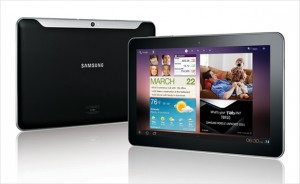Formerly known by its codename “Falcon Ridge,” the next generation of Intel’s Thunderbolt interface will officially be known as “Thunderbolt 2.” The Thunderbolt technology has become one of the standard ports for Apple computers, but has experienced slower adoption with PCs. Intel is hoping that the mainstream adoption of 4K video technologies will help drive interest in the next iteration of its high-bandwidth Thunderbolt bus. Continue reading New Thunderbolt 2 from Intel Doubles Bandwidth, Targets 4K
Quantum dot technology reportedly makes displays more colorful while consuming less power, and development by 3M and Nanosys is nearly ready for use in smartphones, tablets and TVs. 3M issued a press release on Tuesday announcing that its Quantum Dot Enhancement Film (QDEF), which allows up to 50 percent more color than current levels in LCD devices, will be made available to manufacturers starting late in the second quarter of this year. Continue reading 3M and Nanosys to Bring Quantum Dot Tech to CE Devices
By
emeadowsMarch 22, 2013
HP Labs has developed a new kind of three-dimensional display that can play hologram-like videos without requiring moving parts or glasses. Videos hover above the screen as viewers walk around them and experience an image or video from up to 200 viewpoints, essentially simulating the experience of moving around an actual physical object. The LCD-based approach could be used by phones and tablets to produce holograms. Continue reading New 3D System Could Help Mobile Devices Create Holograms
By
George GerbaJanuary 3, 2013
In addition to the highly anticipated array of UHD TVs, new smartphones, Android devices, cloud developments and Internet-connected everything, next week’s CES promises interesting new products and services related to a number of sectors not yet drawing the same amount of press attention. Watch for news involving small flexible displays, green technology, home automation, home projections systems, 3D printing and more. Continue reading CES 2013: Trends Flying Somewhat Under the Radar

By
Rob ScottMarch 29, 2011
Engadget reports that Samsung Semiconductor has revealed plans to drastically increase the pixel density of the company’s tablets. Samsung projects that it will have tablet PC displays with 300 to 400 pixel-per-inch (ppi) resolutions as early as 2015.
Samsung’s current Galaxy Tab has a seven-inch, 1024 x 600 panel (about 170ppi), but the company suggests that similarly sized tablets may go beyond 1080p as pixel density increases (while still maintaining 8-10 hours of battery life). Samsung also said it would consider a glasses-free tablet display, based on consumer adoption of stereoscopic 3D.
The iPad 2 was originally expected to come with a Retina Display like the iPhone 4 screen from LG, but it didn’t happen. Rumors have already begun circulating about a Retina Display for the iPad 3 if the cost remains competitive.
As tablets go well beyond 1080p resolution, what will that mean for content producers?
By
Rob ScottMarch 6, 2011
Sony announced it will soon offer a professional monitor aimed at TV and film production industries that contains the largest commercial organic light-emitting diode (OLED) screen yet produced. OLED is a flat-panel technology that rivals liquid-crystal display (LCD), with pixels that contain an organic material that emits its own light when energized, so screens can be made thinner and more efficient. OLED also displays brighter and richer images than LCD panels.
Despite recent tech advances, manufacturers have had a difficult time getting OLED production to the point where it can create reliable larger screens. Smaller screens designed for cell phones and portable devices have not been an issue, but larger screens have remained problematic. Despite earlier prototypes and announced plans from the likes of Sony, Samsung and LG, we have yet to see OLED TVs larger than 11-inches on the consumer market.
Sony is positioning the new Trimaster EL professional OLED monitors for use in editing bays, satellite trucks, and broadcasting control rooms. Expect to see the 25-inch screen ($28,840) by May 1 and a 17-inch model by July 1.
